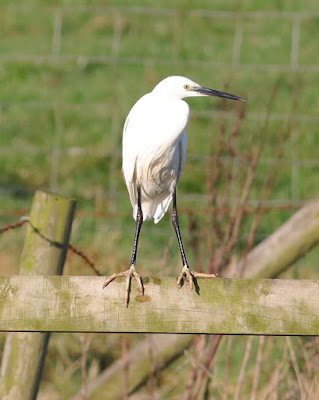When I got up and looked outside I could see a slight frost together with a little breeze shaking the bare branches of the weather-vane damson tree.
I decided on a spot of local birding instead of a ringing session in the bare set-aside field within yards of the coast. And in any case Andy had told me he was going for an MOT - his car, I think. Whether the old banger will last for another year or two is up for debate.
A thin layer of frost soon cleared from the windscreen and luckily the roads were dry and ice-free so I drove over the bumpy moss road towards Pilling. There was a Barn Owl hunting in the half-light, a couple of Song Thrush in good voice, and then about 40 Fieldfares leaving a roost. The Fieldfares flew up to tree tops for a brief look around before they set off for their day of searching the fields.
I stopped to look across the moss at a Little Owl location to see not an owl but a Kestrel atop the nest box. Desirable houses are at a premium around here, but I doubt a Kestrel would even get through the small front door, never mind raise a family of five in such an enclosed space. It’s a dwelling perfect for a small owl, a Stock Dove, or maybe a Jackdaw, not a Kestrel.
Kestrel
I was due to feed our Linnets. There are now a couple of Pheasants to feed, not to mention the several Stock Doves that arrived without an invitation. Birds are very skilled at finding food. Perhaps they do it from a mix of luck, experience, and through a process of watching and following their own or other species? But almost exclusively we feed Linnets, and no other passerines. Today they flew around until I counted two tight flocks of 100 and 80 that joined together and then dropped into the field and away from the seed I had left and where there is still natural food.
The regular Little Egret is not interested in our seed and prefers to spend the day hunting the adjacent ditch.
Little Egret
Several thousand Pink-footed Geese had dropped into the fields at Sand Villa where birders later found White-fronts, Barnacles and Beans and the likely escape/feral Red-breasted Goose. I got close to an overflow of several hundred geese close to Lane Ends and enjoyed their company until noisy cyclists came by and sent the geese off into the air again. The flock was exclusively Pink-footed Geese and I could not find any of the aforementioned species.
For birders hoping to see oddities amongst the mainstream pinkies, according to shooters plus some of my own observations today and in the week, there are 10-20,000 geese scattered in many different flocks in a good number of localities.
Pink-footed Geese
Pink-footed Geese
Sparrowhawks can be very elusive but I saw three today, all in different places, so there was no chance of duplication. One was a large adult female which sat briefly at the top of a row of conifers. The other two sightings were of smaller males which gave momentary views as they did their customary flap-glide and rapid disappearing act across the path of my approaching car. A female Sparrowhawk is half as big again as a male with corresponding weights and measurements in the hand. When caught for ringing purposes there are two different ring sizes for a Sparrowhawk, “E” for female and “D” for the smaller male.
Sparrowhawk
At home I did a spot of garden ringing with mainly Goldfinch, a Blackbird or two but not the single Fieldfare which rather likes sitting and chuckling aloud from the top of our neighbour’s sycamore.
Fieldfare
There’s more soon from Another Bird Blog. Now go back and “click those pics” for a close up.
Linking today to World Bird Wednesday and Anni's Birding Blog.






























































.jpg)











